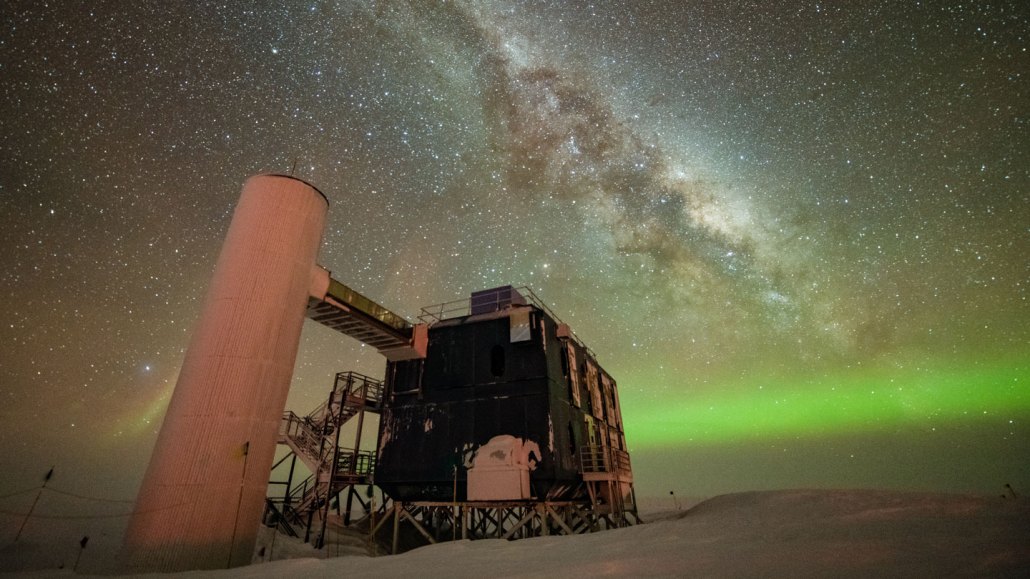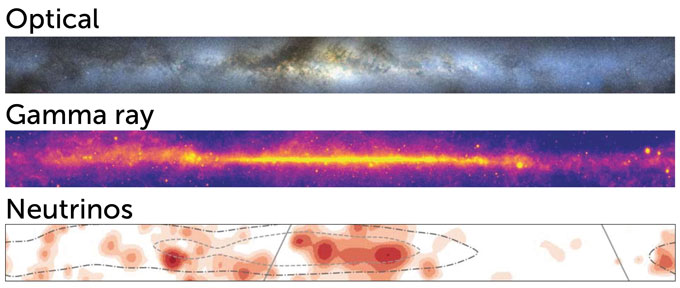
Artificial intelligence helped pick neutrino needles from a haystack of data collected by the IceCube neutrino detector (an aboveground lab, shown) in Antarctica to draw a new map of the Milky Way.
Yuya Makino, IceCube/NSF
- More than 2 years ago
Read another version of this article at Science News Explores
Scientists have made the first image of the Milky Way using neutrinos.
The extremely low-mass subatomic particles have no electric charge, and pass easily through gas, dust and even stars on their way from the places where they originate to detectors here on Earth. High-energy neutrinos zip throughout the cosmos, but where they come from is usually a mystery.
Now, by combining artificial intelligence and data collected over the course of a decade with the IceCube detector in Antarctica, researchers have found the first evidence of high-energy neutrinos that originated from inside the Milky Way and mapped the particles onto an image of the galaxy’s plane. It’s the first time our galaxy has been imaged with anything other than light.
The map includes suggestions of specific high-energy neutrino sources within the Milky Way that might be the remnants of past supernova star explosions, the cores of collapsed supergiant stars or other as-yet-unidentified objects, the team reports in the June 30 Science. But more research is needed to clearly pick those sorts of features out of the data.
Previously, only a few high-energy neutrinos have been traced back to their potential birthplaces, all outside the Milky Way. Those include two that appeared to come from black holes shredding their companion stars and others from a highly active galaxy known as a blazar (SN: 5/16/22, SN: 7/12/18).
“We’re quite unambiguously seeing neutrinos from both galactic and extragalactic space these days,” says physicist Kate Scholberg of Duke University who was not involved with the research. “There’s so much more to learn, and it can be tremendous fun to figure out how to see the universe with neutrino eyes.”
Neutrino astronomy could potentially allow us to see distant objects in a way that no other telescopes can match. That’s because neutrinos can cross huge expanses of space without being absorbed or deflected. X-rays, gamma rays, optical light and the charged particles that make up cosmic rays, on the other hand, can be deflected or absorbed along the way, which may obscure their origins.
To physicist Naoko Kurahashi Neilson of Drexel University in Philadelphia, the map she and her team produced is the latest contribution to a shift in neutrino science. In the past, neutrino observatories like IceCube haven’t provided the sorts of views of the sky that telescopes relying on optical light, X-rays or gamma rays offer.
“When I first joined IceCube,” Kurahashi Neilson says, “I used to do air quotes” when using the phrase neutrino astronomy. “I don’t do that anymore.… I don’t have to because we’re starting to resolve things” in neutrino images that resemble the astronomical images from other telescopes.
Three ways to map the Milky Way
In these three views, the Milky Way is seen in visible light (top), in gamma rays (middle) and in high-energy neutrinos (bottom). This first-ever particle-based map is based on data collected with the enormous IceCube detector embedded deep in the Antarctic ice. Dust obscures portions of the visible light map, and gamma rays can come from a variety of sources. Neutrinos have the potential to pinpoint locations where high-energy cosmic rays coming from supernova remnants, the cores of collapsed stellar giants and other as-yet-unidentified sources interact with dust in the galaxy, creating the neutrinos.

The downside of neutrinos is that they’re extremely hard to detect. The IceCube experiment is enormous in part to overcome that challenge. It consists of 5,160 sensors in a cubic array one kilometer on a side embedded deep in the Antarctic ice. The large size of the experiment increases the odds of seeing a tiny fraction of the neutrinos flying through space from the Milky Way and other places in the cosmos.
Of the 100,000 or so neutrinos that IceCube scientists observe each year, some leave long tracks in the detector that potentially point back to where the neutrinos came from. Many of the neutrino signals in IceCube, though, are known as cascade events. They make bursts of light in the detector, but don’t reveal neutrino origins as well as tracks can.
“This is data we used to throw away in terms of astronomy,” Kurahashi Neilson says. There’s still information indicating where the neutrinos come from in the data. But it’s difficult to identify the promising cascades in the hundreds of thousands of meaningless, background events that IceCube has collected.
Kurahashi Neilson decided to take up the challenge by plowing through a decade of IceCube cascade data with the help of an artificial intelligence system known as a neural network. “You can train the neural nets to identify which events are worth keeping … [and] which events are more background-like,” Kurahashi Neilson says.
It’s an approach Kurahashi Neilson pioneered in 2017 and steadily improved until she and her colleagues were able to identify the neutrinos used in the new map.
“It’s an impressive analysis and the techniques may well not yet be pushed to their limits,” Scholberg says. “Clearly a lot more work needs to be done, but it’s very exciting to see the basic expectation [of Milky Way neutrinos] verified. This is an important step forward in understanding of the high-energy particle sky.”







